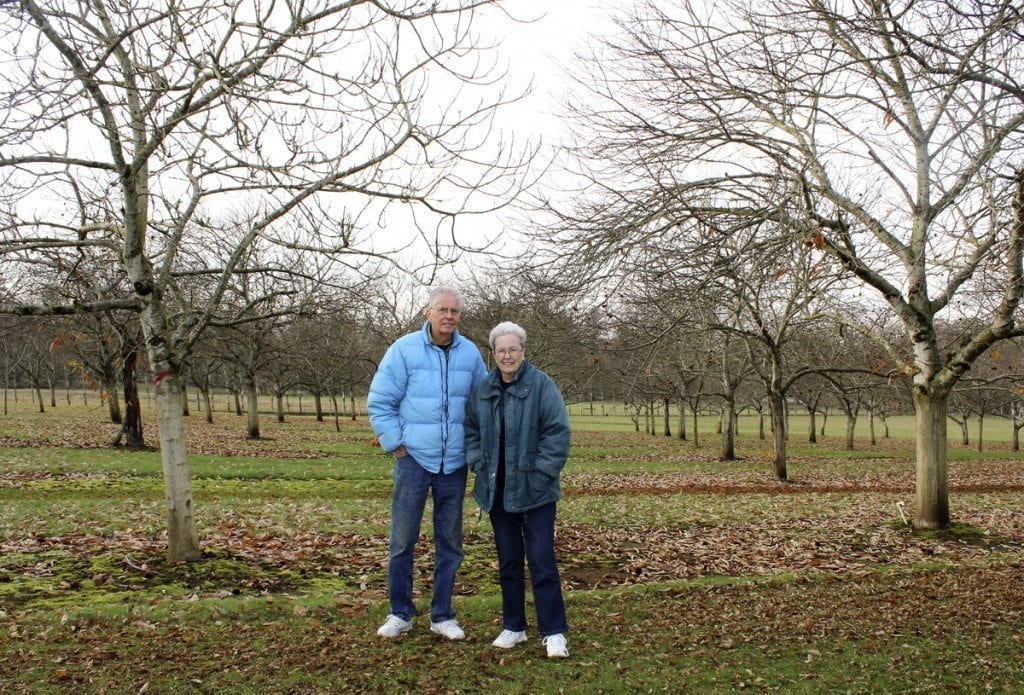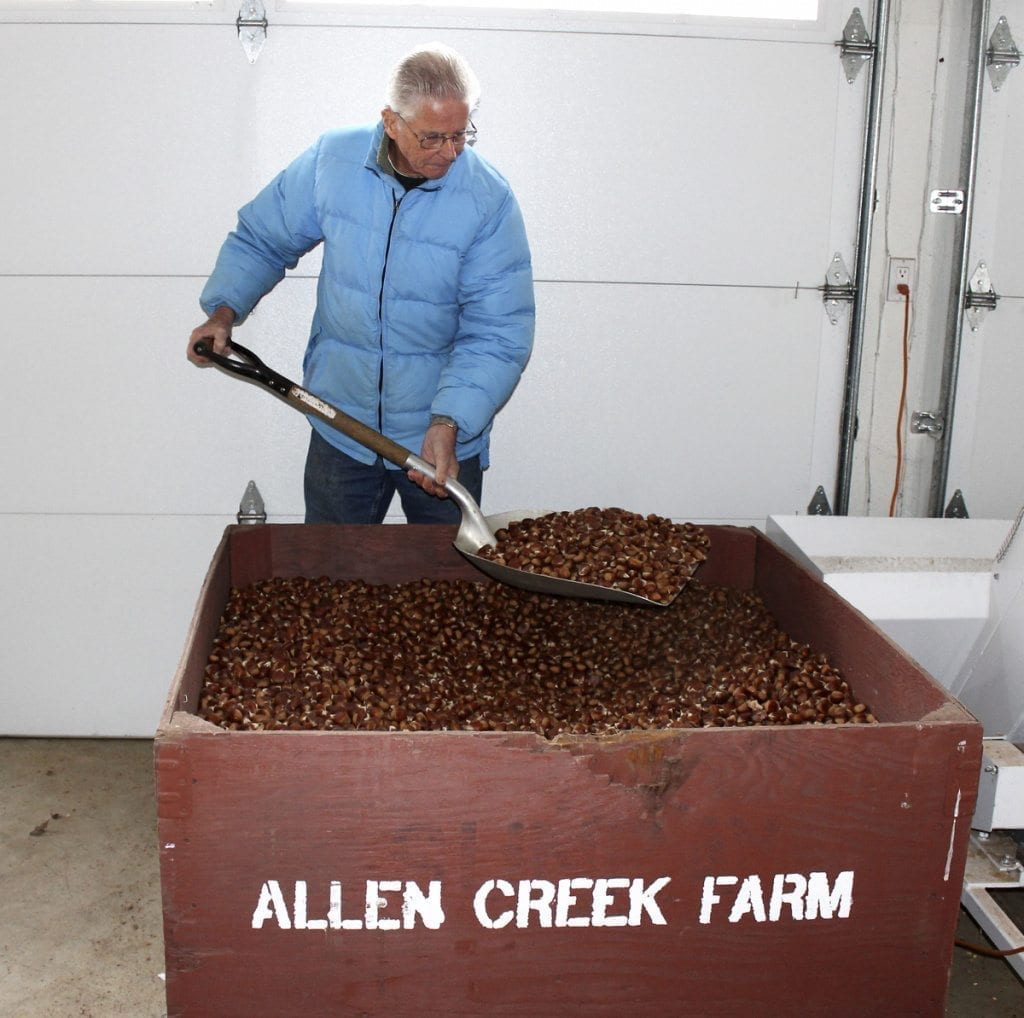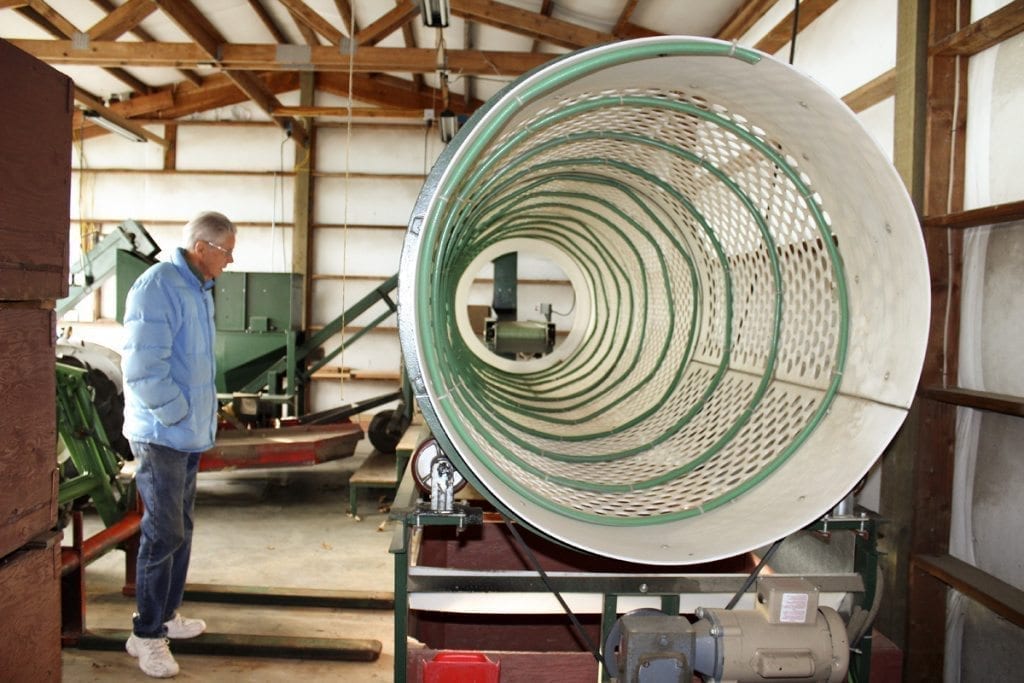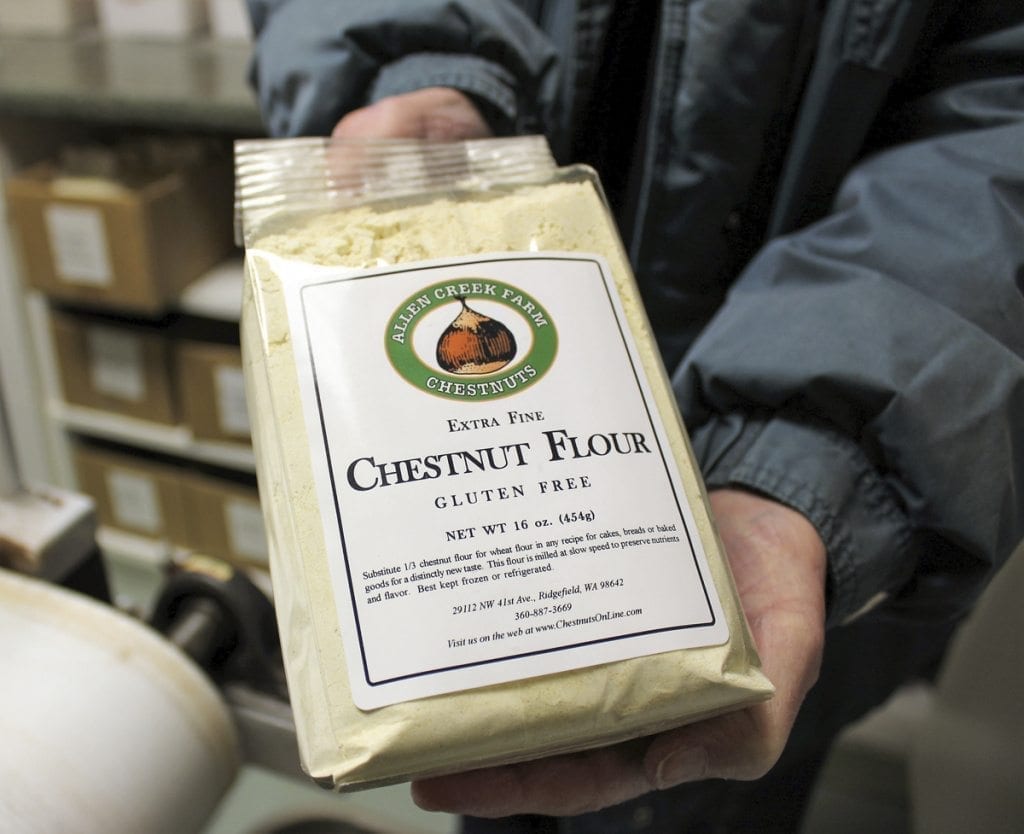RIDGEFIELD — It’s one of those clear, chilly December days when the ice has melted and the wind has called gone on strike for a few hours.
Like any good farmer, Ray Young, 80, is taking advantage of the lull in between snow and ice storms. He’s spent most of the morning clearing his farm’s periphery of evergreen branches — twisted off from the first ice storm of the season and scattered unceremoniously around the sprawling Ridgefield property. Now it’s early afternoon and he’s riding a mulcher, slowly making his way through the rows of nearly 800 chestnut trees on his Allen Creek Farm.
Mulching the leaves, he explains, helps keep down the amount of fertilizer needed to grow the farm’s nearly 10,000 pounds of chestnuts. It also makes the farm look nice and tidy — something that Ray’s wife, Carolyn, appreciates.

Inside the couple’s spacious ranch-style house on the Ridgefield farm, Carolyn is telling a visitor about how the couple decided, more than 20 years ago, to give up their life as Californian teachers, move to Washington State where they knew no one, and start what is, today, one of only about 100 chestnut farms in all of North America.
The story started with tragedy, Carolyn says.
“Ray was a teacher,” she recalls. “And, one day, one of his students, a boy he’d worked with and had tried to help, he was murdered on his way home from school … well, it just destroyed Ray. We were only 56, but we decided to retire early.”
Having already bought the 20-acre Ridgefield property for their later years, the Youngs decided to leave the city life of California and head north. A farm wasn’t immediately on their radar, Carolyn says, but they were looking forward to having enough space for their other passion — raising bassett hound puppies.
“We could only have three dogs in California, but here we could have a hobby kennel and were allowed to have 10 dogs,” she explains. “We haven’t done that for a while. Now we’re down to one dog.”
One elderly bassett hound … plus 780 other babies in the chestnut orchard to care for.
“Yes, it’s a lot of work,” Carolyn says. “But it’s been fun.”

About 20 years ago, the couple decided they needed to actually use the 20 acres they were living on for its intended agricultural purposes. But they didn’t want to be controlled, with someone else telling them what to grow on their own property, Carolyn says. Instead, they were looking for a non-commodity crop that would grow well in Southwest Washington and not require a ton of labor hours.
The chestnut, once a staple for people living in the eastern United States, appealed to them. The infamous nut appealed to the Youngs. After all, who doesn’t get the classic “The Christmas Song” with its refrain of “chestnuts roasting on an open fire, Jack Frost nipping at your nose” stuck in their heads each and every December? And then there’s the history of the famous American chestnut blight, which decimated the American chestnut tree during the first half of the 20th century, killing more than four billion trees and leaving just a handful of American chestnuts in the United States.
The novelty of growing chestnuts intrigued the Youngs, but then they visited a few chestnut farms in the Pacific Northwest as well as in Europe — including some historic chestnut farms in Italy — and realized that, with a little ingenuity, they could tweak some farming equipment to help them run a 20-acre chestnut farm without having to hire expensive laborers each year.
“We used laborers one year, but it was very expensive … and we had trouble finding people who wanted to do the work,” Carolyn says. “We did have a few Mexican laborers once and they were wonderful workers. But it’s hard to find people.”
Instead of harvesting their chestnuts by hand, like many farmers do, the Youngs decided to repurpose an old harvester and hazelnut sweeper to collect their annual yield of fresh chestnuts. The process has worked for them and cut down on the labor costs.
Having already raised two children and worked professionally for nearly 40 years when they moved to Ridgefield, the Youngs weren’t your typical farmers. They understood how to make the business side of things work, too. Ray was an industrial arts high school teacher for many years, so he’s got a handle on how to build, maintain and fix the farm equipment. And Carolyn, a math teacher turned computer science guru, was able to build the farm’s website in the late ‘90s and sell the couple’s chestnuts and chestnut products online earlier than many competitors.

Other strokes of ingenuity and DIY farming dot the grounds at Allen Creek Farm. There is the giant nut sorter the Youngs constructed, which slowly turns the chestnuts, sending them down a spiral of garden hoses, to drop through small, medium, large and extra-large holes. The smallest chestnuts — those that are smaller than one inch in diameter — fall through the first holes, dropping into a bin where they’ll be dried and eventually used to make the Young’s special gluten-free chestnut flour. The other nuts will be sold fresh or dehydrated and sold as dried chestnuts.
The chestnut harvest starts in mid-September. The Youngs start taking orders for chestnuts in October and, by mid-December, they’ve usually sold out of their fresh chestnuts, which are perishable and must be shipped within three days, and are working through orders for their dried chestnuts and sweet-tasting, gluten-free chestnut flour.
The Youngs are one of very few chestnut growers who also process and mill chestnut flour on-site. Carolyn says she only knows of about three or four others in North America.
“People always wanted the fresh, but then they caught on to the dried chestnuts and now we have people who love the chestnut flour,” Carolyn says. “For people who can’t eat gluten, it’s very good … and it’s rare to have an allergy to chestnuts. They have found, however, that people who have a latex allergy sometimes have a chestnut allergy too. But it’s not common.”

Walking around the farm, it’s easy to see how much work and time goes into it. First there is just the simple maintenance and caring for the trees themselves. Then there’s the harvesting, the sorting, the cleaning, the drying, the processing, the packaging and the shipping — all of which is done on site. Add to that the marketing, the working with customers, keeping track of orders and getting ready to do it all again the next year.
But for Ray and Carolyn, the rewards of farming have — for the past two decades, at least — been more than worth the effort.
Now, however, the couple is facing their 80s and they’ve decided that, as much as they love Allen Creek Farm, the time has come to say goodbye. Earlier this year, the Youngs put their farm on the market and decided to downgrade. They’re building a smaller house with about one-twentieth the land in Battle Ground. And, says Carolyn, they’re looking forward to this second shot at retirement.
“We didn’t do it right the first time,” Carolyn jokes of her and Ray’s decision to retire by becoming farmers. “This time, we’re actually going to retire.”
Recipes from Allen Creek Farms
The following recipes are taken, with permission, from the Allen Creek Farm’s website and include one recipe (the chestnut tea cookies) that calls for chestnut flour, another that uses dried chestnuts (the chestnut hummus) and a third (the chestnut bisque) that calls for fresh chestnuts. Hope you enjoy! And, if you try these recipes and like them, look for more chestnut-inspired foods here.
Note: You can print the recipes when viewed on a desktop computer (or turning your mobile device sideways) and save them to a free Yumprint account.
[yumprint-recipe id=’2′][yumprint-recipe id=’3′][yumprint-recipe id=’4′]




